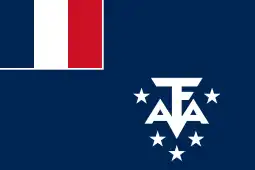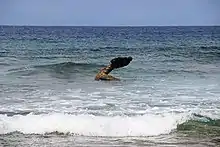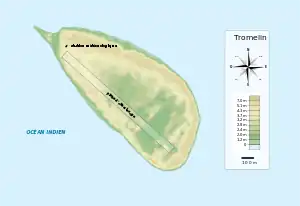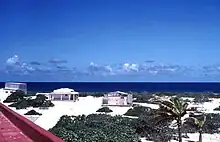Tromelin Island
Tromelin Island (/ˌtroʊmlɪn/; French: Île Tromelin, pronounced [il tʁɔmlɛ̃]), once called the Isle of Sand, is a low, flat island in the Indian Ocean about 500 km (310 mi; 270 nmi) north of Réunion and about 450 km (280 mi; 240 nmi) east of Madagascar. Tromelin is part of the Scattered Islands in the Indian Ocean, the fifth district of the French Southern and Antarctic Lands, a French Overseas Territory, but Mauritius claims sovereignty over the island.
Tromelin Island | |
|---|---|
 Flag | |
| Motto: "Liberté, égalité, fraternité" | |
| Anthem: La Marseillaise | |
| Official languages | French |
| French Overseas Territory | |
• Discovered by Jean Marie Briand de la Feuillée | 1722 |
• French claim to sovereignty | 29 November 1776 |
| Currency | Euro (EUR) |
| ISO 3166 code | TF |
| Internet TLD | .tf |
| Disputed island | |
|---|---|
 Location of Tromelin and other Scattered Islands in the Indian Ocean | |
| Etymology | Jacques Marie Boudin de Tromelin de La Nuguy |
| Geography | |
| Location | Indian Ocean |
| Coordinates | 15°53′32″S 54°31′29″E |
| Administration | |
| Overseas territory | French Southern and Antarctic Lands |
| District | Scattered Islands in the Indian Ocean |
| Claimed by | |

Tromelin has facilities for scientific expeditions and a weather station.[1] It is a nesting site for birds and green sea turtles.
Etymology
The island is named in honour of Jacques Marie Boudin de Tromelin de La Nuguy, captain of the French corvette Dauphine. He arrived at the island on 29 November 1776, and rescued eight stranded enslaved Malagasy people who had been on the island for 15 years.[2]
Description


Tromelin is situated in the Mascarene Basin and is part of the Îles Éparses. It is currently only 7 m (23 ft) high.[3] It formed as a volcano,[4][5] now eroded, and developed an atoll ring of coral.[3]
Tromelin is about 1,700 m (1.1 mi) long and 700 m (0.43 mi) wide, with an area of 80 hectares (200 acres), covered in scrub dominated by octopus bush[6] and surrounded by coral reefs.[3][7] Access by sea is quite difficult as there are no harbours and the only anchorage, to the northwest of the island, is poorly situated.[7] The best, but by no means ideal, landing area is on the east side of the northern peninsula.[7] A 1,200-m (3,900-ft) airstrip provides a link with the outside world.[8]
Fauna and flora
Flora is poorly developed due to weather conditions and lack of fresh water. With the exception of two or three months in summer, this flat island is swept day and night by heavy winds that are sustained in winter. In summer, it can suffer the onslaught of cyclones and tropical storms.
There is only grass and brush (low shrubs) present on the island. Veloutaries (Heliotropium foertherianum) and purslane (Portulaca oleracea), with growth shaped by a dominant east winds are present everywhere on the island.
The fauna consists mainly of hermit crabs (Paguroidea), seabirds, and sea turtles for which the island is an important nesting place. The green turtle (Chelonia mydas) is mainly encountered and, to a lesser extent, the hawksbill sea turtle.
The waters are rich with fish. The French Coral Reef Initiative (IFRECOR) has identified 26 species of corals. Allochthonous species were introduced on the island during the various shipwrecks: rats, mice and rabbits. The latter were decimated in 1986 by cyclone Erinesta.
Important bird area
The island has been identified as an Important Bird Area (IBA) by BirdLife International because of its significance as a seabird breeding site. Both masked (with up to 250 pairs) and red-footed boobies (up to 180 pairs) nest on the island. Sulidae populations have seriously declined in the western Indian Ocean with those on Tromelin among the healthiest remaining.
The island's masked boobies are of the western Indian Ocean subspecies (Sula dactylatra melanops), of which Tromelin is a stronghold.[9] The red-footed boobies constitute the only polymorphic population in the region, indicating its biogeographical isolation. Both great and lesser frigatebirds used to nest on the island. The breeding populations of both birds have since been extirpated, although they continue to use the island for roosting.
There are no resident landbirds.[6]
History

The island was discovered by France in 1720s.[10][11] It was recorded by the French navigator Jean Marie Briand de la Feuillée and named Île de Sable ("Isle of Sand").[12]
Wreck of the ship Utile
On 31 July 1761[13] the French ship Utile ("Useful"), a frigate of the French East India Company, chartered by Jean-Joseph de Laborde and commanded by Captain Jean de La Fargue, transporting slaves from Madagascar to Mauritius in contravention of Mauritian law, ran onto the reefs of the island.[14] The ship had departed Bayonne in France with 142 men. After a stopover on Mauritius (then called the Isle de France), the ship embarked 160 Malagasy men, women, and children at Foulpointe, on the east coast of Madagascar, to bring them into slavery on Mauritius, despite the prohibition of trafficking decreed by the governor. A navigation error, due to the use of two conflicting charts, caused the vessel to wreck on the reefs of Tromelin Island (then called the Isle of Sand). The ship was a frigate, not a slave ship, and thus was not equipped with the shackles and chains usually found on slave ships.[15]
After the wreck, the crew and about 60 Malagasy people managed to reach the island, but the rest of the slaves, locked in the hold, drowned. The crew retrieved various equipment, food and wood from the wreckage. They dug a well, providing drinking water, and fed on salvaged food, turtles, and seabirds.[15]
Captain Jean de Lafargue lost his mind as a result of the wreck, and was replaced by his first lieutenant, second-in-command, Barthelemy Castellan du Vernet who lost his brother Leon in the shipwreck. Castellan built two camps, one for the crew and one for the slaves, a forge and an oven, and with the materials recovered from the wreckage, began construction of a boat.[15] On 27 September 1761, a contingent of 122 French sailors (crew and officers) left Tromelin aboard the Providence. They left the surviving slaves – 60 Malagasy men and women – on the desert island, promising to return and rescue them.[14]
The sailors reached Madagascar in just over four days and, after a stopover in Foulpointe, where men died of tropical diseases, were transferred to Réunion Island (then named Bourbon Island), and then to Mauritius (then called the Isle de France). When the crew of the ship reached Mauritius, they requested that colonial authorities send a ship to rescue the Malagasy slaves on the island. However, they met with a categorical refusal from the governor, with the justification that France was fighting the Seven Years' War and thus no ship could be spared, the island of Mauritius being itself under threat of attack from British India.[16]
Castellan left Mauritius (Isle de France) to return to France in 1762 and never gave up hope to one day return to the Isle of Sand to save the Malagasy people. The news of the castaway slaves got published and stirred the Parisian intellectual milieu; later, the episode was all but forgotten with the end of the Seven Years' War and the bankruptcy of the East India Company.[15]
In 1773, a ship passing close to Tromelin Island located the slaves and reported them to the authorities of Isle de France. A boat was sent, but this first rescue failed, as the ship could not approach the island. A year later, a second ship, Sauterelle, also failed to reach the island. During this second failed rescue, a sailor managed to swim to the island, but he had to be abandoned by the ship due to bad weather. This sailor remained on Tromelin Island and, some time later, probably around 1775, built a raft on which he embarked with three men and three women, but which disappeared at sea.[15]
It was not until 29 November 1776, 15 years after the sinking, that Ensign Tromelin-Lanuguy, captain of the corvette Dauphine,[2] reached Tromelin Island and rescued the survivors – seven women and an eight-month-old child.[5][16] Upon arriving there, Tromelin-Lanuguy discovered that the survivors were dressed in plaited feather clothes and that they had managed, during all these years, to keep a fire lit (the island did not have a single tree). The Malagasy people, who had been left on the bleak little island, built a shed with coral stones, for most of the wood had been used in the construction of the raft for the crew. They also built a lookout on the highest point of the island in order not to miss the ship that would, they hoped, come to their rescue. They were all from the Central Highlands of Madagascar, and had no knowledge of how to produce food in the coastal environment. Most had died within the first few months on the island.[12] The survivors remained with Jacques Maillart, governor of Mauritius (Isle de France), who declared them free and offered to bring them back to Madagascar, which they refused.[15] Maillart decided to baptize the child Jacques Moyse (Moses), on the day of his arrival in Port-Louis on 15 December 1776, and to rename his mother Eve (her Malagasy name was Semiavou) and to do the same with the child's grandmother, whom he called Dauphine after the name of the corvette that rescued them.[15] The trio was welcomed in the house of the intendant of Mauritius (Isle de France). Tromelin was the first to precisely describe the island that now bears his name.[15]
In 1781 the Marquis de Condorcet recounted the tragedy of the castaways of Tromelin, to illustrate the inhumanity of the slave trade, in his book Reflections on the Slavery of Negroes advocating the abolition of slavery.[15]
Expedition "Forgotten slaves"
An archeological expedition entitled "Forgotten Slaves", led by Max Guérout, a former French naval officer and director of operations of the Naval Archeology Research Group, and Thomas Romon, archaeologist at INRAP (National Institute for Preventive Archaeological Research), took place from October to November 2006, under the patronage of UNESCO and the French Committee for the History and Remembrance of Slavery (CPMHE). The results of the research were made public on 17 January 2007. The ten members of the expedition probed the wreck of Utile, and searched the island for traces of shipwreck, in order to better understand the living conditions of the Malagasy people during these fifteen years.[15] According to Max Guérout, head of the mission, "In three days, a well 5 meters [16.5 feet] deep was dug. This represented a considerable effort. We found many bones of birds, turtles, and fish." One does not have the impression that these people were crushed by their condition. They tried to survive with order and method."[15]
An anonymous logbook, attributed to a writer of the crew, was found. Basements made of beach sandstone and coral were also found (the survivors thus transgressed a Malagasy custom according to which stone constructions were reserved for tombs). There were also six copper bowls and a pebble used to sharpen knives. The fire was maintained for fifteen years, thanks to the wood from the wreck, the island being devoid of trees.[15]
A second expedition, organized in November 2008, did not reveal the burials observed in 1851 by an English naval officer. However, the remains of two bodies displaced during the digging of the foundations of a building of the weather station have been uncovered. Three buildings built with coral blocks have been discovered, including the kitchen, which was still equipped with kitchen utensils, and in particular copper containers that had been repaired several times, testifying to the Malagasy's determination to survive.[15]
A third archaeological mission took place in November 2010. It allowed the discovery of three new buildings and many objects, including two lighters and flints, which elucidated the technique used by the castaways to rekindle the fire.[15]
The fourth expedition, took place in September–October 2013. It lasted for 45 days, and enabled the identification of many tools and shelters, as well as the layout of the site.[15]
In 2016, an exhibition presenting the results of the various excavation campaigns, entitled "Tromelin, the island of forgotten slaves", was presented jointly in metropolitan France and in the DROM: At the Stella Matutina Museum in Saint-Leu (La Réunion), the castle of the Dukes of Brittany in Nantes, the House of Agglomeration of Lorient, the Aquitaine Museum in Bordeaux, the departmental museum of archeology and prehistory of Martinique in Fort-de-France, and finally to the Basque Museum of the History of Bayonne from June to November 2017.
Sovereignty claims
Tromelin is administered as part of the French Southern and Antarctic Lands, a French Overseas Territory, but Mauritius claims sovereignty over the island despite its absence in the listing of the 8th article of the 1814 Treaty of Paris.[17] Indeed, the treaty does not specifically mention all the dependencies of Mauritius, which leads to uncertainty on the sovereignty of Tromelin, and the official text was that written in French. During the British period of Mauritius, France administered the island as a dependency of the region of Réunion and built infrastructure without British protest. France and Mauritius have been negotiating for years in regard to the possible establishment of a condominium over the island. In 2010, Mauritius and France reached an agreement on the co-management of Tromelin, without prejudice to the sovereignty of Mauritius over Tromelin.
The French claim to sovereignty dates from 29 November 1776,[18] the date that the ship Dauphine arrived.
The Mauritian claim to sovereignty is based on the fact that the island must have been ceded to United Kingdom by the treaty of Paris in 1814 and should not continue to be administered by France as a dependency of Réunion.
The United Nations never recognized the Mauritian sovereignty over Tromelin. In 1954, France constructed a meteorological station and a landing strip on the island.[19]
It is a matter of dispute whether the building agreement transferred sovereignty of Tromelin from one to the other, and Mauritius claims the island as part of its territory, on the grounds that France did not retain its sovereignty over the island in 1814, which was de facto part of the colony of Mauritius at the time of independence.[20] Indeed, as early as 1959, even before independence, Mauritius informed the World Meteorological Organization that it considered Tromelin to be part of its territory.[21] A co-management treaty was reached by France and Mauritius in 2010,[22] but has not been ratified.[23]
Tromelin has an Exclusive Economic Zone (EEZ) of 280,000 km2 (108,109 sq mi), contiguous with that of Réunion. The island's weather station, which warns of cyclones, is still operated by France and is staffed by meteorologists from Réunion.
Climate
Tromelin Island has a tropical savanna climate (Köppen climate classification Aw). The average annual temperature in Tromelin is 26.7 °C (80.1 °F). The average annual rainfall is 1,073.7 mm (42.27 in) with February as the wettest month. The temperatures are highest on average in February, at around 28.7 °C (83.7 °F), and lowest in August, at around 24.3 °C (75.7 °F). The highest temperature ever recorded in Tromelin was 36.3 °C (97.3 °F) on 1 January 1983; the coldest temperature ever recorded was 17.4 °C (63.3 °F) on 12 July 1964.
| Climate data for Tromelin Island (1991–2020 averages, records 1955–present) | |||||||||||||
|---|---|---|---|---|---|---|---|---|---|---|---|---|---|
| Month | Jan | Feb | Mar | Apr | May | Jun | Jul | Aug | Sep | Oct | Nov | Dec | Year |
| Record high °C (°F) | 36.3 (97.3) |
34.9 (94.8) |
34.4 (93.9) |
33.3 (91.9) |
31.6 (88.9) |
30.0 (86.0) |
28.5 (83.3) |
28.8 (83.8) |
29.6 (85.3) |
31.7 (89.1) |
33.8 (92.8) |
33.9 (93.0) |
36.3 (97.3) |
| Average high °C (°F) | 31.2 (88.2) |
31.3 (88.3) |
31.0 (87.8) |
30.3 (86.5) |
29.1 (84.4) |
27.4 (81.3) |
26.4 (79.5) |
26.6 (79.9) |
27.1 (80.8) |
28.2 (82.8) |
29.5 (85.1) |
30.7 (87.3) |
29.1 (84.4) |
| Daily mean °C (°F) | 28.6 (83.5) |
28.7 (83.7) |
28.6 (83.5) |
28.0 (82.4) |
26.9 (80.4) |
25.3 (77.5) |
24.3 (75.7) |
24.3 (75.7) |
24.7 (76.5) |
25.7 (78.3) |
26.9 (80.4) |
28.1 (82.6) |
26.7 (80.1) |
| Average low °C (°F) | 26.0 (78.8) |
26.2 (79.2) |
26.1 (79.0) |
25.7 (78.3) |
24.7 (76.5) |
23.1 (73.6) |
22.1 (71.8) |
22.0 (71.6) |
22.3 (72.1) |
23.2 (73.8) |
24.3 (75.7) |
25.5 (77.9) |
24.3 (75.7) |
| Record low °C (°F) | 20.5 (68.9) |
22.3 (72.1) |
20.9 (69.6) |
20.8 (69.4) |
19.5 (67.1) |
18.1 (64.6) |
17.4 (63.3) |
17.8 (64.0) |
18.0 (64.4) |
18.2 (64.8) |
19.6 (67.3) |
20.5 (68.9) |
17.4 (63.3) |
| Average precipitation mm (inches) | 136.0 (5.35) |
185.9 (7.32) |
155.1 (6.11) |
142.7 (5.62) |
68.5 (2.70) |
60.3 (2.37) |
69.2 (2.72) |
48.4 (1.91) |
50.0 (1.97) |
31.8 (1.25) |
42.7 (1.68) |
83.1 (3.27) |
1,073.7 (42.27) |
| Average precipitation days (≥ 1.0 mm) | 12.9 | 14.0 | 14.2 | 13.0 | 10.4 | 11.2 | 13.6 | 11.4 | 10.1 | 7.4 | 6.1 | 9.4 | 133.6 |
| Source: Météo France[24] | |||||||||||||
References
- "[no title cited]". New Scientist. Vol. 145. 14 January 1995. p. 10.
- Annexe 2. Biographie de Jacques Marie Boudin de Tromelin, seigneur de Lanuguy. 28 November 2019. pp. 245–261. ISBN 9782271130426. Retrieved 24 April 2020.
{{cite book}}:|website=ignored (help) - Marriner, Nick; et al. (2012). "A geomorphological reconnaissance of Tromelin Island, Indian Ocean". Journal of Coastal Research. 28 (6): 1606–1616. doi:10.2112/JCOASTRES-D-11-00029.1. S2CID 128621103.
- Fisher, Robert L.; Johnson, George L.; Heezen, Bruce C. (1967). "Mascarene Plateau, Western Indian Ocean". GSA Bulletin. Geological Society of America. 78 (10): 1247–1266. Bibcode:1967GSAB...78.1247F. doi:10.1130/0016-7606(1967)78[1247:MPWIO]2.0.CO;2.
- Marriner, Nick; Guérout, Max; Romon, Thomas (2010). "The forgotten slaves of Tromelin (Indian Ocean): New geoarchaeological data". Journal of Archaeological Science. 37 (6): 1293–1304. doi:10.1016/j.jas.2009.12.032.
- "Tromelin". Important Bird Areas factsheet. BirdLife International. 2012. Retrieved 7 January 2012.
- "Chapter III: Islands and Banks East of Madagascar". Sailing Directions for the South Indian Ocean, Madagascar and the Islands West of Longitude 90° East. Washington, D.C.: U.S. Government Printing Office. 1945. p. 124.
- Atoll Research Bulletin. Smithsonian Institution. 1951.
- African Wildlife. Wildlife Society of Southern Africa. 1974.
- Russell, James (11 April 2016). "The Recovery of Tromelin Island". National Geographic Society (blogs). Retrieved 26 August 2017.
- The World Factbook 2016-2017. Government Publications Office. United States Central Intelligence Agency. 18 August 2016. pp. 269ff. ISBN 978-0-16-093327-1 – via Government Printing Office.
- "La Revue Maritime N° 477" (PDF). Ifm.free.fr. Paris, FR: Institut Français de la Mer. December 2006. Retrieved 26 August 2017.
- Guérout (2015), p. 27.
- "Lèse humanité". The Economist. 16 December 2015. Retrieved 26 August 2017.
- Guérout, Romon; Max, Thomas (2015). Tromelin, l'île aux esclaves oubliés. France: CNRS Editions.
- "Shipwrecked and abandoned: The story of the slave Crusoes". Independent.co.uk. 5 February 2007. Retrieved 26 August 2017.
- "Treaty of Paris". 1814. Art. VIII.
«His Britannic majesty stipulating for himself and his allies, engages to restore to his most Christian majesty, within the term which shall be hereafter fixed, the colonies, fisheries, factories, and establishments of every kind, which were possessed by France on the 1 January 1792, in the seas and on the continents of America, Africa, and Asia, with the exception however of the islands of Tobago and St. Lucie, and of the Isle of France and its dependencies, especially Rodrigues and Les Sechelles, which several colonies and possessions his most Christian majesty cedes in full right and sovereignty to his Britannic majesty, and also the portion of St. Domingo ceded to France by the treaty of Basle, and which his most Christian majesty restores in full right and sovereignty to his Catholic majesty»
- "Ce n'est que quinze ans plus tard, le 29 novembre 1776, que le chevalier de Tromelin récupérera huit esclaves survivants : sept femmes et un enfant de huit mois. Le pavillon français fut planté sur l'île qui fut ainsi nommée Tromelin en hommage à ce chevalier". Archived from the original on 31 January 2012. Retrieved 26 August 2017 – via archive.org.
- Charney, Jonathan I.; Colson, David A.; Alexander, Lewis M. (2005). International Maritime Boundaries. Martinus Nijhoff Publishers. p. 3463. ISBN 9004144617.
- Forbes, Vivian Louis (1995). The maritime boundaries of the Indian Ocean region. Singapore University Press. p. 110. ISBN 9971691892.
- Rumley, Dennis; Chaturvedi, Sanjay; Sakhuja, Vijay (2010). Fisheries Exploitation in the Indian Ocean: Threats and Opportunities. Institute of Southeast Asian Studies. p. 123. ISBN 9789812309860.
- "Tromelin : La Réunion, spectatrice et spoliée". Lequotidien.re. Archived from the original on 10 October 2017. Retrieved 15 December 2011.
- "Mauritius".
- "Tromelin (984)" (PDF). Fiche Climatologique: Statistiques 1991–2020 et records (in French). Meteo France. Archived from the original (PDF) on 27 February 2018. Retrieved 26 February 2018.
External links
- Lichfield, John (5 February 2007). "Shipwrecked and abandoned: the story of the slave Crusoes". The Independent.
- "Lèse humanité: What happened when slaves and free men were shipwrecked together". The Economist. 19 December 2015.
- "Tromelin, la isla de los malgaches resilentes". navegar-es-preciso.com (in Spanish).
- Guérout, Max (2015). Tromelin, Mémoire d'une Ile. Paris: CNRS Éditions. p. 278. doi:10.4000/books.editionscnrs.27814. ISBN 9782271086662 – via openedition.org.